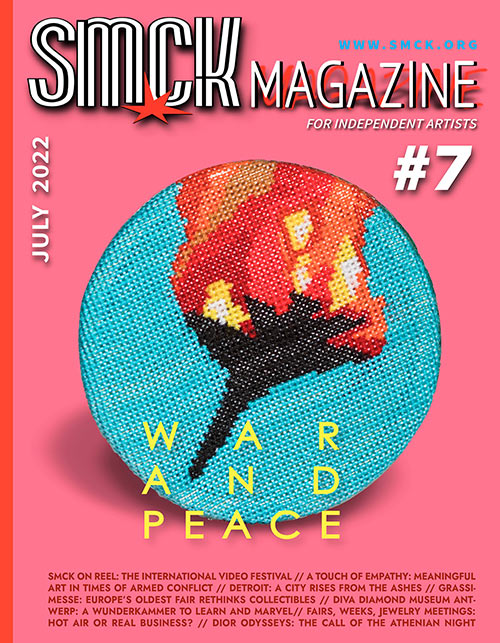WHY DOESN'T CONTEMPORARY JEWELRY TAKE OFF?
WHILE THE ART MARKET IS FLOURISHING, THE MARKET FOR CONTEMPORARY JEWELRY IS HELD BACK.
By Loukia Richards
 Waves. Photo: Christoph Ziegler.
Waves. Photo: Christoph Ziegler.
If you do an internet search for "contemporary jewelry auctions" or "author jewelry auctions", you won't find a plethora of entries.
But what do we mean by these terms? "Contemporary jewelry" or "author jewelry" are wearable objects that share the mission of contemporary art: to ask uncomfortable questions, to explore new intellectual territories, to re-envision cultural truisms, to challenge established tastes, to reshape social landscapes, to highlight environmental concerns.
Everything about these objects is unique, controversial, unusual, and either sits on the border of disciplines or is beyond categorization, transitional and interdisciplinary, spiritual and profane, in the same way as contemporary art.
Auctions are not the only mechanism for setting an artwork's price, documenting its market value and fluctuations, promoting it, or ultimately spreading its aesthetic benefits to the broader public. But auctions are an important tool for the art market, a type of fever chart, as it reminds people that there is art "out there" that will become the life companion of proud owners who spotted the piece while their creators were still unknown – and bring monetary gains over time, too.
To most outsiders, the art world looks like a jungle: labyrinthe, arcane, fabled, enchanting; home to people chasing dreams of eternal glory – although, in reality, art promises only 'blood, sweat and tears' to those dedicating their lives to serve her and gives no guarantee of material success.
To invest in something or even bid against competitors to purchase it means that the object casts an exceptionally powerful spell on many people.
 "1UP Wreck". Photo: Christoph Ziegler.
"1UP Wreck". Photo: Christoph Ziegler.
Recent reports from prominent international auction houses show an expansion of the art disciplines they focus on and sell. Groups of artists previously excluded from society and prestigious art institutions due to their ethnic origins, religion, gender, education, health, color or race, sexual orientation, and so on, or artists who had worked with disciplines considered "inferior art", such as commercial printing or industrial design, are now 'runners' in a broader and less biased art market.
But contemporary jewelry is not.
At the same time that the art market is flourishing – due in part to money's depreciation and increased social prestige of owning and understanding art – the market for contemporary jewelry is not.
The less artists can make a living from their work, the less frequently they are able to attend industry meetings; the fewer options they have to show their work, the more difficult it becomes to sustain fairs, weeks, and other opportunities. This is a vicious circle. The numbers speak volumes. There is a sharp decline in the number of artists participating in prestigious fairs or weeks over the last five years.

Walk. Photo: Christoph Ziegler.
While rigid institutional structures do not address the problem, the braver ones among us should admit: we have to fix the problem before it is too late. Contemporary jewelry as a genre or art discipline must open up to the broader public. This is a task for individual artists, but it also requires a collective effort.
Before professionals join forces, they should be aware that the lack of communication between the different agents and sectors of the contemporary jewelry field inhibit the discipline’s growth.
What has held it back?
1. Institutional partners whose job is to educate the pubtlic, cultivate sector prestige, and set the quality standards are not necessarily willing to learn why the market is important to artists and why it is important that artists earn their living from selling their work and ideas.
2. Academics whose job is to educate students and cultivate their professional skills do not necessarily know or even like the market. Often, they do not understand the agony of their students for the day after graduation.
3. Gallerists do not realize that the market is far more competitive now because contemporary jewelry falls between art genres vying for buyers with an incredible variety of artworks and astonishingly affordable prices. A new generation of art collectors must be educated in appreciating jewelry art.
4. The media – of cardinal importance in promoting trends – does not know what contemporary jewelry is because nobody explained why this genre is unique using arguments that can be understood by professional journalists.
5. The jewelry scene’s influencers do not care to expand the market because their VIP status will be threatened once their fans are exposed to new influences.
6. The established jewelry houses do not recruit contemporary jewelry artists because they are ignorant of their potential or even their very existence.
If this diagnosis is correct, then change will not come from heaven. “You cannot make an omelet without breaking eggs,” Vladimir Lenin stated more than a century ago. Contemporary jewelry needs to make an omelet – that is to say, it needs to revolutionize its mindset.
Homepage: www.loukiarichards.net
Instagram: @loukiarichards







